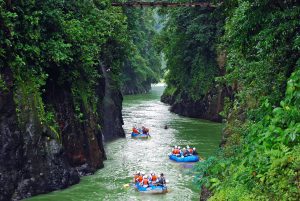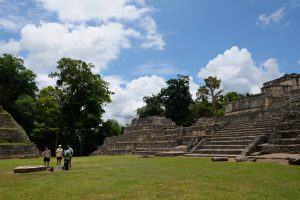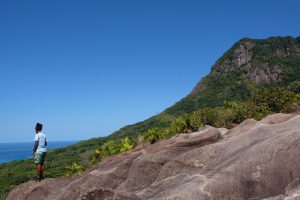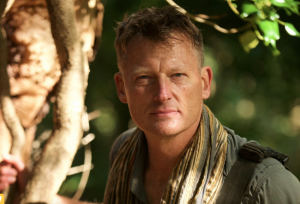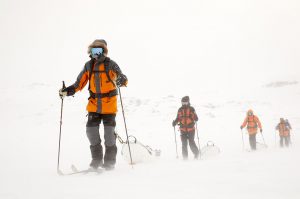
A new expedition is offering aspiring explorers a taste of Antarctica, all from the wilds of western Norway. Training amid the same topography that shaped the likes of Ernest Shackleton, learn to camp and cross-country ski with legendary polar guides.
Read online at nationalgeographic.com
In the wilds of western Norway, in a remote village half-buried in snow, dusk is decorating the crisp, white landscape with an otherworldly wash of blue. From the frozen Finsevann lake and the Hardangerjøkulen glacier beyond, to the spindrifts and snow banks piling up outside my hotel, Finse 1222, the world suddenly offers a new colour spectrum: lapis, cerulean, sapphire. This is the ‘blue hour’, the twilight period when the sun’s blue wavelengths dominate all others, and it’s a spectacular phenomenon most easily witnessed in frozen climes. For those of us newly arrived at this outpost from temperate UK latitudes, the transfiguration of the landscape has a quieting effect. We know that in just a few days, at the end of a course involving survival skills and ski touring, we’ll be pitching tents out in that subzero blue.
A voice at my shoulder draws my attention from the hotel window back into the cosy library. It reminds me I’m not going to be alone in this undertaking. Pouring Champagne into flutes and encouraging our group to take seats around the roaring fireplace is Louis Rudd, a record-breaking polar explorer and the newly appointed director of expeditions at Shackleton — the adventure-grade clothing company founded in the great explorer’s name and endorsed by his granddaughter, Alexandra Shackleton.
At Louis’ side is Wendy Searle, our expedition manager, the seventh woman in history to ski solo and unsupported from Hercules Inlet to the South Pole. Together, they curated and helped to launch Shackleton Challenges in 2022, a programme of skills training and seriously intrepid expeditions that aims to equip novices and adventurers alike to survive in one of the most extreme places on the planet: Antarctica.
“We chose Finse for our Level One Polar Skills Challenge because it’s the spiritual heart of the exploration community,” Louis tells us. “To think that Robert Falcon Scott, Ernest Shackleton and Roald Amundsen trained here, maybe even planning their legendary expeditions in this very room, sends shivers down my spine.” Winter conditions in Finse are said to be as close as you can get to Antarctica without crossing the Southern Ocean. Since Finse 1222’s founding in 1909, it’s attracted a stream of illustrious adventurers, photos of whom decorate the foyer of this newly updated, Scandi-chic property.
Our party is interrupted by the arrival of one of the world’s most famous living polar explorers, Børge Ousland, the first person to cross Antarctica solo. The tall, quietly spoken Norwegian is on a skiing trip with his family. “Finse is a home-from-home for me; I’ve been coming here since I was a boy. In the summer, I fish for trout and dive with my little daughter off the jetty,” he says, hinting at the landscape now encased beneath winter’s heavy snows.
Børge and Louis share their latest exploits. Louis has recently returned from a 400-mile expedition in Antarctica that also included climbing the 16,050ft-high Mount Vinson and running the Antarctic Ice Marathon. Børge, meanwhile, is currently attempting to traverse the world’s 20 largest glaciers and has completed nine so far. They share a strange vocabulary forged by lives spent seeking the world’s most extreme places: “remote base camps”; “logistics companies”; “expedition gear”; “polar topography”. The group listen intently, mouths slightly agape.
Wendy shows her cross-country skis to Børge. They’re the pair she’ll take to the South Pole in December when attempting to break the women’s speed record. They’re steel-edged, produced by Åsnes and have Børge’s face printed across the front, as part of a collaboration. He inscribes them with a Sharpie: ‘Travel light, think ahead and leave your fears behind’. “I think you can do it,” he says, handing them back with an encouraging nod.
Fortitudine vincimus
Out on the frozen Finsevann lake, a blizzard has set in. Winds reaching 45mph howl around our convoy of ski-tourers, each kitted out in polar-grade jackets and pulling a plastic pulk (a low-slung Nordic sled) that’s carrying our camping equipment for the night ahead. Visibility is very low; with the horizon obscured, depth and distance evaporate. My world becomes small and somehow serene. I observe my breath and the varied textures of the icy terrain just visible at my feet. In the snow fields of Antarctica, sastrugi (wave-like drifts of snow carved by wind and erosion) can grow to a metre high or more. Here, they amount to undulating ripples — still enough to regularly trip me up. I concentrate on Louis’ outline ahead, placing my skis in his tracks and trying to match his pace.
“It’s a very immersive, simple existence — it’s addictive,” Wendy had told me during our training, describing her 42-day crossing of Antarctica, which she completed in January 2020. “The noise and politics of normal life fades away.” Holed up in the library, we’d covered the basics of navigation as well as avalanche training and rescue, and how to set up polar tents and cook on a primer stove. We also made a list of essential and inessential kit. “It’s all about weight,” said Wendy. “When packing for a polar trip, we’re looking at every gram. Cut the labels off your clothing, snip the tabs off zippers and saw the handle off your toothbrush. I cut off my long hair to save 30g on a comb!”
Louis and Wendy were keen to talk about the rigours of a fitness and nutrition regime, as well as the sponsorship needed to financially support a major polar expedition and the mental hardship involved in ‘soloing’. “They say that if you’re crossing Antarctica alone, the closest human might be on the International Space Station,” said Wendy. “Trusting my own judgement was the hardest thing and it took time. But I learnt I had reserves of endurance I never knew were there.” Now, her job with Shackleton Challenges is all about showing people the route to completing a similarly life-changing polar expedition. “If I can do it — a normal mother of four with a big dream, who couldn’t even ski when she started training — anyone can.”
The temperature is a biting -5C as we execute our set-up plan, pegging the tent in line with the howling wind, shovelling snow around the base for insulation and digging a trench beneath the canvas porch for cooking and urination. Once inside, we fire up the stove, heating snow to pour into our freeze-dried rations for dinner. I wolf down my hot salmon and broccoli risotto, followed by a mug of hot chocolate. Then it’s a quick scamper through the blizzard to the other tent, for a nightcap and the sharing of stories.
Wendy shows us a tattoo on her arm, reading: ‘Fortitudine vincimus’. It’s the Shackleton family’s motto, meaning ‘By endurance we conquer’. Louis reveals he has the same words inked on him. The hardy spirit and dogged leadership of Sir Ernest Shackleton, whose ill-fated ship Endurance was finally discovered by archaeologists at the bottom of the Weddell Sea in March 2022, is something explorers aspire to. “There’s a famous saying by explorer Raymond Priestley, born out of the golden age of polar exploration,” says Louis. “‘For scientific discovery give me Scott; for speed and efficiency of travel give me Amundsen; but when disaster strikes and all hope is gone, get down on your knees and pray for Shackleton.’ I think that says it all.”
Back in my own tent, shared with Wendy, cocooned in a duck-feather sleeping bag, I listen to the wind rage outside and try to stifle my fear. I think of the monuments to brave explorers dotted around the Finse 1222 hotel: the plinth memorialising Scott, buried in snow in the front courtyard; and the replica, down on the lakeshore, of Amundsen’s wooden Framheim hut, in which he and his men had overwintered on the Ross Ice Shelf before his successful quest for the South Pole.
In the darkness, I ask Wendy what drives her to keep exploring one of the world’s most inhospitable places. “There’s a magic that happens in the gap between your comfort zone and your ambition,” she says, quietly. “And I’m never alone out there. I always feel Antarctica is with me.”
How to do it
Shackleton Challenges vary in length and difficulty, with destinations including Norway, Iceland, the French Alps and Antarctica. On the six-day Finse Polar Skills Challenge (Level One), guests complete a 10-mile ski-tour through the wilderness of Western Norway and learn how to camp out in subzero temperatures as part of a small, expert-led group. The price of £6,495 includes expedition training, all meals, accommodation at Hotel Finse 1222, the use of polar camping and trekking equipment, a Shackleton jacket and domestic rail tickets for the ‘snowtrain’ to Finse (from Bergen or Oslo). International flights are not included. Trips are now available to book for March and April 2023.
Published in the Winter Sports 2022/23 guide, part of the December 2022 issue of National Geographic Traveller (UK)





